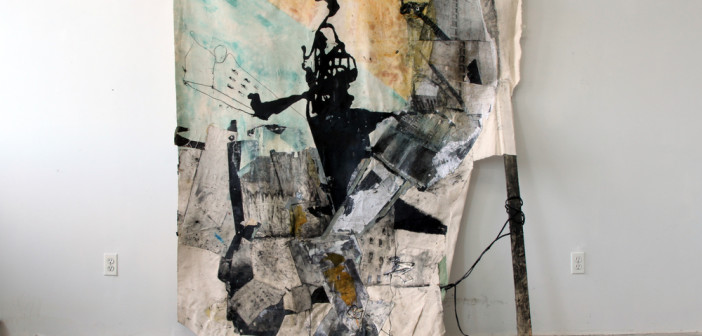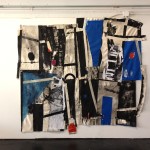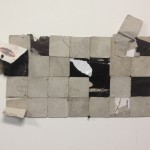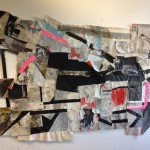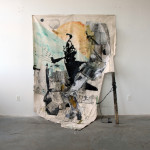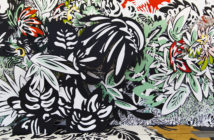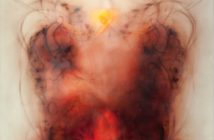If I allude to several previous artists in this review, it is not because I find Washington's work derivative. Rather, I think he's working in the established tradition of modernism/postmodernism, and that he's as conscious of these influences as I am. Some of those called to mind are due to techniques of style and execution. Others because they, like Washington, confronted issues of race in America while trying to construct a self-identity revealed at least in part through their art-making processes.
Washington's paintings are monochrome (a point stressed most rigorously by his nearly minimal black and white prints). Occasional colors intrude (plastic tarpaulin blue, shiny gray duct tape, limited hazes of red or gold for atmospheric effect, colorful bits of packaging), but they are counterpoint only; the main show is black, white, gray and brown. Most of the largest paintings, un-stretched, read like crazy-quilt patchworks of detritus, seamed and sewn and taped and glued together, then simply tacked or nailed to the walls. They give a sense of seeming fragility, of rags fugitively gathered, prone to sinking back into chaos and disarray.
But they are probably quite sturdy. The look of disordered decay is part of Washington's gestural approach, preserving the sense that human hands found all these fragments and parts and put them together in new syntheses. It's the collage of synthetic cubism preserving the gestures of wear and tear, an abstract expressionism that supports and enhances the compelling themes found therein, many of them dealing with childhood and adolescent development. The time when imagery meant so much more than words, and being inarticulate was to be expected.
"Boogey Man" is a cloud of black, pouring through the center of the composition, coalescing as if in a childhood bedroom, out of a closet of toys. Only when examined does the cloud really start to take form, that you notice adult black eyes staring out from within, perhaps the face of the man the child became. "Dyno-Mite In My Room" uses a more recognizable central figure of Jimmie Walker, star of the Norman Lear topical 1970s sitcom "Good Times." The TV show focused on the struggles of an urban family living in a Chicago projects setting, and Walker is now seen as the center of a composition in an interior. Is this clownish presence a role model, someone for a child in search of icons to aspire to?
Jean-Michel Basquiat once looked for role models in science fiction and superheroes (as well as jazz musicians), though his paintings were initially celebrated more for their vibrant execution than their possible meanings. In "Final Frontier," Washington depicts a black void covering the wall. But down in one corner, the Starship Enterprise seems intent on boldly going into it. Looking closely, we see a black male body superimposed on the Starship, which may represent a search for a black captain (found in Deep Space Nine in later years in the person of Captain Sisko), or an identification with the promise of the ship itself and its diverse crew.
"Black Moon Rising" makes me think of two art world icons, Romaire Bearden and Robert Rauschenberg simultaneously, but for different reasons. Both addressed the 1960s Space Race in their collages, but to different ends. Rauschenberg seemed to celebrate the Camelot dream of America taking a giant step forward, amidst a never-ending overload of popular images that spread across his serial screen sprints. Bearden contrasted urban life in the city to the pipe dream of white-suited astronauts landing on the moon, as if one could have no relevant connection to the other.
Maybe it's a third creator I think of the most in this image, however, the writer Samuel Delany, whose book Dhalgren (1974) chronicled a destroyed city after a cataclysm, peopled by free spirits, frightened conformists and strange new subcultures garbed like monsters. In Washington's painted assemblage, a presence like tangled black yarn seems to rise up between skewed buildings, while a baleful moon or sun glowers in a sliver of blue sky. The canvas itself hangs and trails from the wall, in one corner supported by a prop-like stick that juts out onto the gallery floor.
Washington has embraced the American tradition of the readymade (Duchamp) and junk art (Kienholz) in creating these paintings, which draw from the past but refer to the still charged state of race relations and cultural politics in the present day. What could be more ambivalent than "Copy," an arrangement of black and white stripes in various orientations that becomes a kind of flag or banner on the wall? When numbers are discerned in the mix of stripes, the origin is clear: a barcode, a method of classification that contradictorily preserves individual distinction while placing every so-marked item in a usable index. This lacerated one, at least, cannot be scanned.
This ambivalence, patterns that strive for order but fray, also characterizes the etchings included in the show. "No-things" explores the grid, but with a loose sort of restraint that seems to indicate a weariness at order imposed from outside. Or perhaps the reverse: an order forming, fitfully and unfinished, out of chaotic debris. Though restrained, it's not pristine, making the prints on paper a telling parallel to the taped squares and rectangles of plastic, canvas and cardboard in the bolder, wilder paintings.

